
Cimexomys is an extinct North American mammal that lived from the Upper Cretaceous to the Paleocene. For a while, it shared the world with dinosaurs, but outlived them. It was a member of the extinct order Multituberculata and lies within the suborder Cimolodonta. It is perhaps a member of the Paracimexomys group, though it is not certain.
Lavanify is a mammalian genus from the late Cretaceous of Madagascar. The only species, L. miolaka, is known from two isolated teeth, one of which is damaged. The teeth were collected in 1995–1996 and described in 1997. The animal is classified as a member of Gondwanatheria, an enigmatic extinct group with unclear phylogenetic relationships, and within Gondwanatheria as a member of the family Sudamericidae. Lavanify is most closely related to the Indian Bharattherium; the South American Sudamerica and Gondwanatherium are more distantly related. Gondwanatheres probably ate hard plant material.
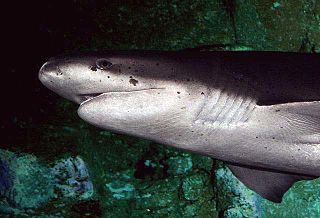
The Hexanchiformes are a primitive order of sharks, that numbering just seven extant species in two families. Fossil sharks that were apparently very similar to modern sevengill species are known from Jurassic specimens.

Chlamydoselachidae is a family of primitive deep-sea sharks in the order Hexanchiformes. They are one of only two extant families in the order alongside the cow sharks in the family Hexanchidae, and the only members of the suborder Chlamydoselachoidei.

Squalicorax, commonly known as the crow shark, is a genus of extinct lamniform shark known to have lived during the Cretaceous period. The genus had a global distribution in the Late Cretaceous epoch. Multiple species within this genus are considered to be wastebasket taxon due to morphological similarities in the teeth.

Cretoxyrhina is an extinct genus of large mackerel shark that lived about 107 to 73 million years ago during the late Albian to late Campanian of the Late Cretaceous. The type species, C. mantelli, is more commonly referred to as the Ginsu shark, first popularized in reference to the Ginsu knife, as its theoretical feeding mechanism is often compared with the "slicing and dicing" when one uses the knife. Cretoxyrhina is traditionally classified as the likely sole member of the family Cretoxyrhinidae but other taxonomic placements have been proposed, such as within the Alopiidae and Lamnidae.

Enchodus is an extinct genus of aulopiform ray-finned fish related to lancetfish and lizardfish. Species of Enchodus flourished during the Late Cretaceous, and there is some evidence that they may have survived to the Paleocene or Eocene; however, this may just represent reworked Cretaceous material.

Chlamydoselachus is a genus of sharks and the sole extant member of the family Chlamydoselachidae, in the order Hexanchiformes. It contains two extant and four extinct species. The most widely known species still surviving is the frilled shark. It is known as a living fossil, along with Chlamydoselachus africana, also known as the southern African frilled shark, which is only found along coastal areas of South Africa. The only two extant species of this genus are deep-sea creatures which are typically weakened in areas closer to the surface. While the two extant species are similar in external appearance, they differ internally.
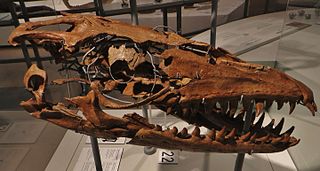
Prognathodon is an extinct genus of marine lizard belonging to the mosasaur family. It is classified as part of the Mosasaurinae subfamily, alongside genera like Mosasaurus and Clidastes. Prognathodon has been recovered from deposits ranging in age from the Campanian to the Maastrichtian in the Middle East, Europe, New Zealand, and North America.
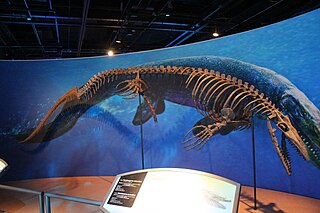
Taniwhasaurus is an extinct genus of mosasaurs that lived during the Campanian stage of the Late Cretaceous. It is a member of the subfamily Tylosaurinae, a lineage of mosasaurs characterized by a long toothless conical rostrum. Two valid species are attached to the genus, T. oweni and T. antarcticus, known respectively from the fossil record of present-day New Zealand and Antarctica. Two other species have been nominally classified within the genus, T. 'capensis' and T. 'mikasaensis', recorded in present-day South Africa and Japan, but their attribution remains problematic due to the fragmentary state of their fossils. The generic name literally means "taniwha lizard", referring to a supernatural aquatic creature from Māori mythology.
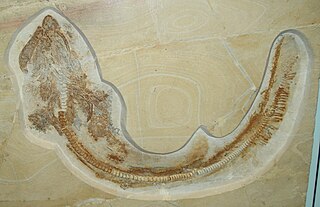
Paraorthacodus is an extinct genus of shark. It a member of the family Paraorthacodontidae, which is either placed in Hexanchiformes or in Synechodontiformes. It is known from over a dozen named species spanning from the Early Jurassic to the Paleocene, or possibly Eocene. Almost all members of the genus are exclusively known from isolated teeth, with the exception of P. jurensis from the Late Jurassic-Early Cretaceous of Europe, which is known from full body fossils from the Late Jurassic of Germany, which suggest that juveniles had a robust body with a round head, while adults had large body sizes with a fusiform profile. There was only a single dorsal fin towards the back of the body without a fin spine. The dentition had teeth with a single large central cusp along with shorter lateral cusplets, which where designed for clutching. The teeth are distinguished from those of Synechodus by the lateral cusplets decreasing in size linearly away from the central cusp rather than exponentially as in Synechodus.

Meristodonoides is an extinct genus of hybodont. The type species is M. rajkovichi, which was originally a species in the genus Hybodus. The species, along with other Hybodus species such as H. butleri and H. montanensis, was reassigned to Meristodonoides by Charlie J. Underwood and Stephen L. Cumbaa in 2010. The species is primarily known from remains from the Cretaceous of North America, spanning from the Aptian/Albian to Maastrichtian, making it one of the last surviving hybodont genera, though records of the genus likely extend back as far as the Late Jurassic, based on an undescribed skeleton from the Tithonian of England, and fragmentary teeth from the Kimmeridgian of Poland, England and Switzerland. Other remains of the genus are known from the Coniacian of England, the Aptian-Albian of France, and the Campanian of European Russia. The morphology of the teeth suggests an adaptation to tearing prey. Fossils from the Western Interior Seaway suggest that it preferred nearshore marine environments, being absent from deeper-water areas, with it likely also being able to tolerate brackish and freshwater conditions.

The Kristianstad Basin is a Cretaceous-age structural basin and geological formation in northeastern Skåne, the southernmost province of Sweden. The basin extends from Hanöbukten, a bay in the Baltic Sea, in the east to the town of Hässleholm in the west and ends with the two horsts Linderödsåsen and Nävlingeåsen in the south. The basin's northern boundary is more diffuse and there are several outlying portions of Cretaceous-age sediments. During the Cretaceous, the region was a shallow subtropical to temperate inland sea and archipelago.
Notidanodon is an extinct genus of cow shark. Fossils ascribed to this genus are known from the Jurassic and Cretaceous periods. Recently, the genus underwent a major revision and was split into two after the erection of Xampylodon to accommodate the species X. dentatus, X. loozi, and X. brotzeni. The genus is now known only from New Zealand, Antarctica, Africa, and South America.
Kawasphenodon is an extinct genus of sphenodontian reptile, known from the Late Cretaceous and Paleocene of Patagonia in South America. The type species, K. expectatus, was described in 2005 from jaw fragments found in late Campanian aged sediments in the Los Alamitos Formation, the jaw when complete was estimated to be 11 cm long, making it among the largest known sphenodontians. A second species, K. peligrensis, around 1/3 the size of the type species, was described in 2014 also from jaw fragments in early Paleocene (Danian) sediments of the Salamanca Formation, making it the youngest known definitive representative of Rhynchocephalia outside of New Zealand. In the original description, it was found to be a member of Sphenodontidae, in some other subsequent analyses it was found to be a member of Opisthodontia. A 2020 analysis of rhyncocephalian relationships found it to be outside Opisthodontia, and instead a member of the Sphenodontinae as the closest known relative of the tuatara, with an estimated divergence between the two genera in the Early Cretaceous. Other subsequent studies have endorsed its placement as a member of Sphenodontidae. Like most other rhynchocephalians, the teeth are acrodont, with a deep dentary, and it probably had an omnivorous habit.

Gypsonictops is an extinct genus of leptictidan mammals of the family Gypsonictopidae, which was described in 1927 by George Gaylord Simpson. Species in this genus were small mammals and the first representatives of the order Leptictida, that appeared during the Upper Cretaceous.
Hessinodon is an extinct genus of possible kitefin sharks that lived during the Late Cretaceous. It contains one valid species, H. wardi, which is known from four teeth from the Northumberland Formation of British Columbia. Its teeth are most similar to those of modern cookiecutter sharks.
Rolfodon is an extinct genus of shark in the family Chlamydoselachidae. It is closely related to the extant frilled sharks in the genus Chlamydoselachus, which it can be differentiated from by tooth morphology. It is named after late Canadian paleontologist Rolf Ludvigsen.
Dykeius is an extinct genus of large shark in the family Chlamydoselachidae. It contains a single known species, D. garethi, from the Late Cretaceous Northumberland Formation of Canada. The genus and species names honor paleontologist Gareth J. Dyke.
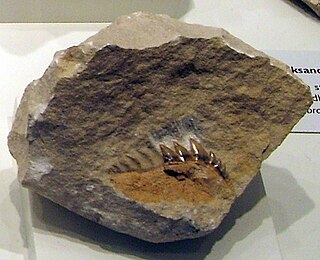
Xampylodon is an extinct genus of cow shark. Fossils assigned to this genus are known from the Late Cretaceous and early Paleocene. Xampylodon was recently erected after a revision on the taxonomy of hexanchid fossil teeth, and includes three species previously included in Notidanodon.













